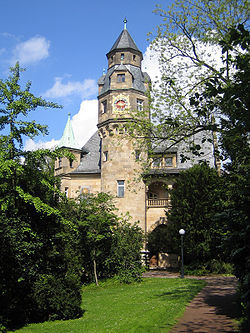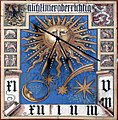Liebieghaus
| Liebieghaus | |
|---|---|
 Museum am Schaumainkai 71, May 2005 |
|
| Data | |
| place | Frankfurt am Main , Hesse |
| architect | Leonhard Romeis |
| Client | Heinrich von Liebieg |
| Construction year | 1896 |
| height | approx. 25 m |
| Coordinates | 50 ° 6 '7 " N , 8 ° 40' 18" E |
| particularities | |
| museum | |
The Liebieghaus Skulpturensammlung is a sculpture museum on the Museumsufer in Frankfurt am Main . In a castle-like historic villa on Sachsenhausen Schaumainkai, the Liebieghaus houses a top-class collection of around 3,000 sculptures from ancient Egypt to classicism . It thus offers an overview of 5,000 years of sculpture history .
history
The Bohemian textile manufacturer Baron Heinrich von Liebieg (1839–1904), a member of the Liebieg family , had the villa built for himself in 1896 as a retirement home; it was designed by the Munich architect Leonhard Romeis .
In 1907 the city of Frankfurt acquired the property and rededicated the house to a museum for the municipal sculpture collection (current name: Liebieghaus Skulpturensammlung).
The first director was Georg Swarzenski , who built up the collection from 1907 and opened the museum in 1909. Since then, important scholars have worked as curators at the Liebieghaus, including the art historians Anton Legner and Herbert Beck (1969–2006) and the archaeologists Peter Cornelis Bol (1974–2006) and Vinzenz Brinkmann (since 2006). From 2006 to 2016 Max Hollein was director of the Liebieghaus sculpture collection. After his departure, Philipp Demandt has been in charge of the Städel Museum , the Liebieghaus in Frankfurt and the Schirn Kunsthalle since October 1, 2016 .
The museum is located on the Schaumainkai in the middle of a garden in which some sculptures are exhibited. Among other things, there is a copy of Dannecker's Ariadne under a small group of trees.
After the renovation by the Berlin office Kuehn Malvezzi , the newly designed exhibition rooms were reopened in October 2009 on the occasion of the 100th anniversary. Together with the extended gallery wing for the presentation of the collection of antiquities as well as the display depots set up as part of a comprehensive new presentation of the collection , the Liebieghaus shows masterpieces from Egyptian, Greek and Roman antiquity , the Middle Ages and the Renaissance , Mannerism , Baroque and Rococo on 1,600 square meters , of Classicism and East Asia and thus offers a well-founded overview of the history of sculpture.
collection
The collection is one of the most important in Europe and includes Greek, Roman and Egyptian sculptures from ancient times as well as pieces from the Middle Ages, Renaissance , Baroque and Classicism as well as works from East Asia.
The Liebieghaus has a universally oriented collection, which is not based on regional art, aristocratic collections or secularized church property, but was bought on the international art market and expanded through foundations. Only comparatively few of the works are therefore associated with Frankfurt or Frankfurt history.
In 2019 a collection of over 200 precious ivory sculptures from the Middle Ages as well as the Baroque and Rococo from the possession of Reiner Winkler was acquired for the Liebieghaus Skulpturensammlung. With this acquisition, the Liebieghaus achieved the most significant expansion of its own holdings in the history of the museum.
The most important pieces include:
- a marble copy of Naukydes' discobolos
- a copy of the Athena statue of the Athena Marsyas group of the Myron
- the Carolingian ivory reliefs of the "Older Metz School" with the testimony of John on a book cover (middle of the 9th century)
- an Ottonian crucifix (mid-11th century)
- a Romanesque king's head from a statue from the Ile-de-France
- by Tino di Camaino : fragments of a Florentine tomb (probably after 1318)
- an alabaster sculpture of the mercy seat by Hans Multscher (around 1430)
- a crescent moon Madonna by Tilman Riemenschneider
- the Rimini Altar , a multi-figure crucifixion group made of alabaster from northern France (around 1430)
- Bärbel von Ottenheim , Sibylle of the late Gothic by Niclas Gerhaert van Leyden (1463/64)
- Johann Heinrich Dannecker's Ariadne auf dem Panther (1803-1805), which the banker Simon Moritz von Bethmann acquired in 1810 . A replica is in the park of the Liebieghaus.
- the fury on a horse (1610) by the so-called fury master made of ivory
Illustrations
Dannecker's Ariadne on the Panther .
Special exhibitions
- 1976: Olympia - An archaeological dig
- 2006: The Fury Master
- 2006: Schön im Leiden - sculptures of the Passion of Christ by Hans Multscher
- 2006/07: The fantastic minds of Franz Xaver Messerschmidt
- 2008: Whims of Olympus. The myth of Athena, Marsyas and Apollo
- 2008: Colorful gods - the colourfulness of ancient sculpture
- 2009: Jean-Antoine Houdon . The sensual sculpture
- 2010: Sahure - Death and Life of a Great Pharaoh
- 2011: ivory. Baroque splendor at the Viennese court
- 2010/11: Niclaus Gerhaert . The sculptor of the Middle Ages
- 2012: Jeff Koons . The Painter & The Sculptor (in cooperation with the Schirn Kunsthalle)
- 2012/13: Art treasures of the patron Heinrich von Liebieg , Museum Giersch , Frankfurt am Main
- 2013: Back to the classic. A new look at ancient Greece
- 2013/14: Nok . An origin of African culture
- 2014/15: The great illusion. Veristic statues and their techniques
- 2015/16: DANGEROUS LOVERS "The Art of French Rococo"
- 2016: Athens. Triumph of images .
- 2017: UNIQUE TO DOUBT "Sculptures and their stories Acquired 1933–1945"
- 2016/17: Holy Night .
- 2017/18: In new splendor. The restored thief fragment by the Master of Flémalle in context
- 2018: William Kentridge . O sentimental machine
- 2018/19: Medea's love and the hunt for the Golden Fleece
- 2020: Colorful Gods - Golden Edition. The colors of antiquity
literature
- Martin Sonnabend: Georg Swarzenski and the Liebieghaus . Liebieghaus, Frankfurt 1990, ISBN 3-7973-0465-X .
- Wolf-Christian Setzepfandt : Architecture Guide Frankfurt am Main / Architectural Guide . 3. Edition. Dietrich Reimer Verlag, Berlin 2002, ISBN 3-496-01236-6 , p. 35 .
- Vinzenz Brinkmann , Maraike Bückling, Stefan Roller: Masterpieces in the Liebieghaus. Liebieghaus sculpture collection . Imhof, Petersberg 2008. ISBN 978-3-86568-364-9 .
- Definitely to doubtful. Acquired sculptures and their stories 1933–1945 . Liebieghaus Skulpturensammlung, Frankfurt am Main 2017, ISBN 978-3-943215-09-0 .
Web links
- Website of the Liebieghaus
- Liebieghaus sculpture collection . In: Museumsufer-Frankfurt.de
- Literature by and about Liebieghaus in the catalog of the German National Library
- State Office for Monument Preservation Hesse (ed.): Liebieghaus In: DenkXweb, online edition of cultural monuments in Hesse
Individual evidence
- ↑ Claus-jürgen Göpfert: Kunsthalle Frankfurt: Demandt also directs the Schirn . In: fr-online.de . July 29, 2016 ( fr.de [accessed on August 6, 2016]).
- ↑ Documentation of the collection in the picture index of art and architecture .
- ↑ Happiness for collectors in the Liebieghaus. In: WELTKUNST, the art magazine of ZEIT. March 25, 2019, accessed February 21, 2020 .
- ↑ White Wedding. Retrieved February 21, 2020 .
- ^ Vinzenz Brinkmann (ed.): Colorful gods. The colors of ancient sculptures. Liebieghaus Skulpturensammlung, Frankfurt am Main. ISBN 978-3-9809701-6-7 .
- ^ Two worlds of forms in FAZ of October 30, 2013, p. 37.
- ↑ How art teaches deception in FAZ from October 4, 2014, p. 11.
- ↑ [1]
- ^ Riddles from the Sea in FAZ from May 30, 2016, page B4
- ↑ [2]
- ^ A heavenly family in FAZ from November 26, 2016, page 13
- ↑ [3]
- ↑ [4]
- ↑ [5]
- ↑ Hans-Joachim Müller: "Colorful Gods": the Frankfurt Liebieghaus shows antiquity in color . In: THE WORLD . January 26, 2020 ( welt.de [accessed February 21, 2020]).





